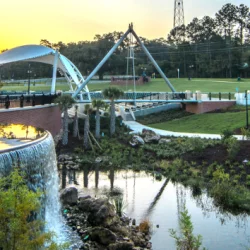The Role of Real Estate in Economic Development
Spanning property development, management, and sales, the real estate sector forms the foundation of many economies. It involves a wide range of activities, including real estate brokerage, property management, and the development of both commercial and residential properties.
“The real estate industry's influence extends far beyond the mere construction of physical structures,” shares Jean Paul Wardy, Co-Founder and CEO of CenterCal Properties, “as it significantly contributes to overall economic growth and impacts various sectors.”
“It plays a crucial role in economic development through infrastructure creation, job generation, and urban renewal,” he adds. Real estate acts as a catalyst for economic activity, stimulating other areas of the economy and generating income. The performance of the is a key indicator of economic trends and often reflects the broader economic climate.
Real Estate as an Economic Driver
The real estate industry is a major job creator, supporting a wide array of employment opportunities, as well as a driver of varied economic activity.
Job Creation
Construction activities, which form the backbone of the industry, involve laborers, engineers, and architects. Additionally, jobs are created in property management, real estate brokerage, and legal services related to real estate transactions. The development of commercial and retail spaces further drives job creation in sectors such as banking, hospitality, and retail.
Catalyzing Economic Activity
Beyond directly creating jobs, the real estate industry stimulates economic growth. The expansion of commercial and residential real estate increases demand for goods and services, thereby boosting other sectors of the economy. For example, the construction of a new mall generates employment in the retail, food service, and entertainment industries.
Multiplier Effect of Investments
The availability of high-quality housing attracts residents and businesses, increasing tax revenues and further stimulating economic activity. The impact of real estate investment is amplified by the multiplier effect, wherein money spent on real estate projects generates income for individuals and firms, who then reinvest that income into other areas of the economy.
Real Estate and Infrastructure Development
Demand for infrastructure is closely linked to real estate development. As cities and populations grow, the need for public infrastructure, utilities, and transportation increases.
Whether a project is residential, commercial, or industrial, infrastructure related to roads, bridges, public transportation, water supply, and electricity must be developed or upgraded. The mutually beneficial relationship between real estate and infrastructure is evident, as well-developed infrastructure raises property values and attracts investment.
Public-private partnerships (PPPs) have become a popular method for funding and executing infrastructure projects. By combining the resources and expertise of the public and private sectors, PPPs can expedite infrastructure development and reduce the fiscal burden on governments.
In these collaborations, real estate developers often play a key role by contributing land, expertise, and financial resources. A successful PPP can result in the creation of high-quality infrastructure that enhances residents' quality of life and promotes economic growth.
Government policies play a significant role in shaping real estate development. Interest rate policies, zoning regulations, and tax incentives can either positively or negatively impact real estate activity. For example, strict zoning laws may limit development opportunities, while tax incentives for home improvements can encourage investment and revitalization. Additionally, infrastructure projects and government-sponsored housing initiatives can have a profound impact on the real estate market.
Real Estate and Urban Revitalization
Real estate development plays a pivotal role in accelerating urban revival in several ways:
Transforming Blighted Areas
Investment in new construction and the rehabilitation of existing structures often help transform neglected areas into vibrant neighborhoods. Real estate projects can attract businesses, create public spaces, and rejuvenate communities. This regeneration process often involves demolishing outdated buildings and replacing them with new ones, significantly enhancing the aesthetic appeal of the area.
Impact on Property Values
Property values are directly influenced by real estate development. As communities are revitalized, property values generally increase due to improved amenities, higher demand, and reduced crime rates. This rise in property values benefits both new investors and existing property owners. However, it is essential to ensure that the benefits of revitalization are equitably shared to avoid displacing long-term residents.
Creating Sustainable Cities
Real estate is also a powerful tool for promoting social and economic inclusion. By incorporating affordable housing into their projects, developers can address the housing needs of low-income groups. Additionally, providing local employment opportunities in construction and property management can help reduce unemployment and poverty rates. The creation of public spaces such as parks, libraries, and schools further enhances the quality of life for residents and fosters social cohesion.
Real Estate and Economic Growth
Real estate is a crucial indicator of the state of the economy. A robust economy, characterized by low unemployment, rising incomes, and increased consumer confidence, is often associated with a thriving real estate market.
Conversely, a struggling real estate market may signal an economic downturn or recession. Because real estate development and investment often predict future demand for goods and services, they are sometimes considered leading indicators of economic activity.
Real estate markets exhibit cyclical patterns influenced by interest rates, consumer sentiment, and overall economic conditions. Economic expansion is typically marked by rising property values, increased construction, and growing rental demand. In contrast, recessions lead to declining property prices, a slowdown in new development, and higher vacancy rates. Understanding these cycles is essential for governments and real estate investors to make informed decisions.
Conclusion
Real estate is a multidimensional force in economic development that generates jobs, stimulates the economy, and propels infrastructure construction. Its dynamic and complex sector is characterized by its cyclical nature and vulnerability to government initiatives.
By comprehending the obstacles and prospects present in the real estate sector, interested parties can make knowledgeable choices and facilitate enduring economic expansion. Building resilient and ecologically friendly communities requires real estate developers to prioritize sustainable practices.
Through the integration of renewable energy, energy efficiency, and green building technologies, the real estate sector can significantly contribute to the mitigation of climate change and the improvement of future generations' quality of life. Real estate's future rests on its capacity to accept innovation, adjust to shifting market conditions, and enhance societal well-being in general.
More to Read:
Previous Posts:




